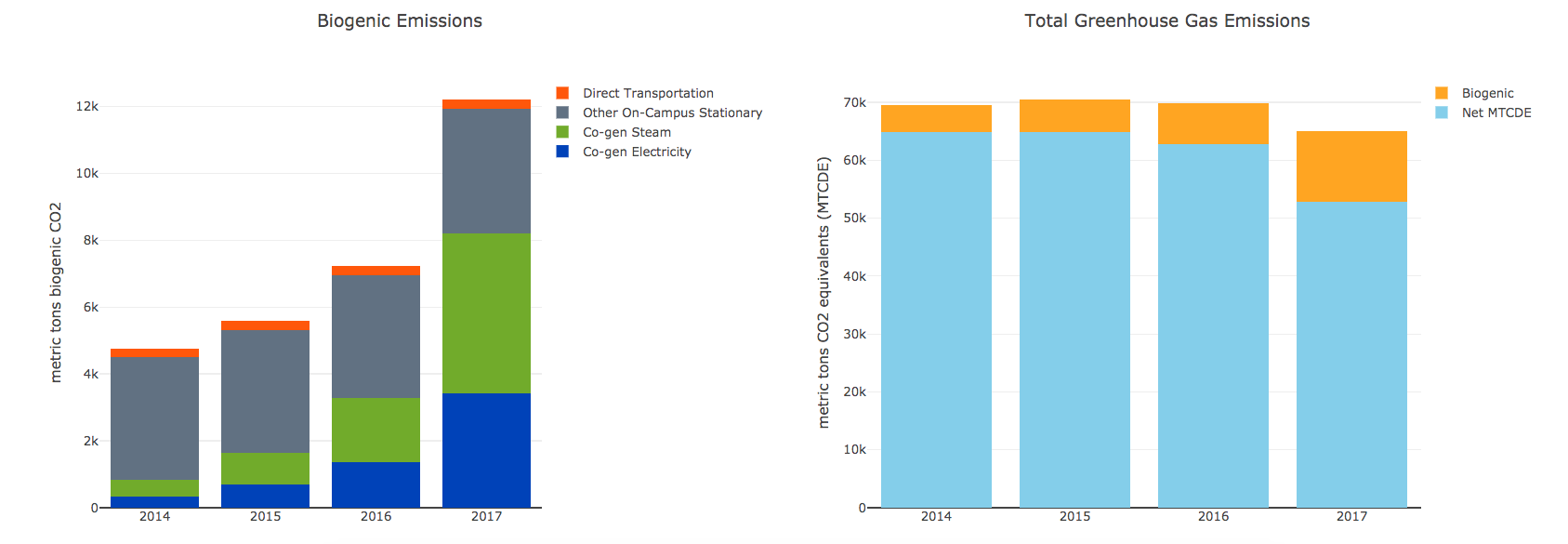The Biogenic Working Group formed in June 2019. Co-facilitated by Second Nature and SIMAP, the Working Group is led by Steve Muzzy and Jenn Andrews. If you are interested in joining the Biogenic Working Group, please contact Steve Muzzy at smuzzy@secondnature.org
What are biogenic emissions?
Biogenic CO2 refers to carbon in wood, paper, grass trimmings, and other biofuels that was originally removed from the atmosphere by photosynthesis and, under natural conditions, would eventually cycle back to the atmosphere as CO2 due to degradation processes. Following the GHG Protocol guidelines, SIMAP separates out biogenic emissions of carbon and considers these emissions to be carbon neutral.
Another aspect of biogenic is land management: Different land management practices can lead to a sink of carbon, or to a release of carbon. Currently, land management is considered non-additional sequestration in greenhouse gas inventories, which means it does not affect your net carbon footprint.
Goals of the Biogenic Working Group
The Biogenic Working Group has been meeting since June 2019 and is made up of campus staff and faculty and decarbonization service providers. The Working Group formed with the initial aim to answer the following questions:
- What is higher ed's contribution (academically, scientifically) to the public comments on the topic to the GHG Protocol?
- How are/should individual campuses utilize bioenergy in their greenhouse gas reduction goals?
- What are the opportunities for the campus sustainability community to recommend how this relates operationally to carbon reduction?
The Working Group has refined its focus to:
- Developing more transparent and comprehensive reporting of organizational carbon emissions.
- The current protocols don't give campuses a good way to talk about the value of avoided emissions from good campus land use and land management decisions.
- Without a life-cycle approach to evaluating energy choices, campuses cannot make good informed decisions or evaluate short- or long-term options.
- The current protocols don't allow for sufficient acknowledgment of impacts that occur on different time scales, and the importance of those different time scales. Partly, this reflects the reality that the scientific understanding is still growing and changing rapidly.
- Anything developed as an alternative needs to be grounded in science and broad stakeholder input.
- If "more transparent/comprehensive" = "more difficult to communicate," that's not helpful.
The Biogenic Working Group has been meeting in parallel with and following the Technical Working Group facilitated by the World Resources Institute on biogenic and land use management. When the WRI Technical Working Group releases its new recommendations on biogenic (expected end of 2021), then this working group will consider how to best incorporate the new guidance into campus greenhouse gas inventories generally and into SIMAP specifically.
Progress to date
The Biogenic Working Group has already contributed to several key SIMAP updates that aim to make biogenic emissions more transparent:
- UNHSI Sustainability Fellow Gabe Desmond analyzed the footprint of bioenergy at Middlebury College
- We updated SIMAP emission factors so that biogenic is separated out from CO2. This also means it is possible to customize biogenic emission factors.
- Added a new report called the Biogenic Emissions Report on the Reports tab, which displays biogenic emissions by category

Next steps
Future goals of the Biogenic Working Group include:
- Releasing the Campus Land Management Report and Carbon Neutrality Report in SIMAP
- Adapting the forthcoming guidelines from the Technical Working Group for higher ed
Biogenic Working Group Members
Alex Barron, Assistant Professor, Environmental Science & Policy, Smith College
Alex French, Sustainability Coordinator, Clarkson University
Allison Leach, Postdoctoral Researcher, UNHSI
Andrew DeMeo, Data Manager, Climate Programs, Second Nature
Ben Newton, Environmental Sustainability Director, Central Community College
Brian Hansen, Director of Environmental Protection, Safety and Sustainability, Hamilton College
Corey Hawkey, Assistant Director, University Sustainability Practices, Arizona State University
Dano Weisbord, Director of Sustainability & Campus Planning, Smith College
David Karlsgodt, Principal, Brailsford & Dunlavey
Jack Byrne, Director of Sustainability Integration, Middlebury College
Jennifer Andrews, Project Director, UNHSI
John Pumilio, Director of Sustainability, Colgate University
Juliette Rooney Varga, Director, Climate Change Initiative , University of Massachusetts, Lowell
Justin Heavey, Sustainability Associate, SUNY College of Environmental Science and Forestry
Karen Kellogg, Associate Professor and Director, Environmental Studies and Sciences, Skidmore College
Levi Rogers, Director of Sustainability Programs and Assessment, Skidmore College
Marianee Jorgenson, Coordinator for Academics for Land Protection in New England (ALPINE), Lincoln Institute
Mary Booth, Director, Partnership for Policy Integrity
Nathan Stewart, Ph.D., Program Director, U.S. Forest Service Internship Program, Associate Professor, Sustainability Studies, Colorado Mountain College
Pamela Gramlich, Assistant Director, Sustainability and PC Environmental Studies, Colgate University
Rory Gaunt, CEO, Life Cycle Renewables
Sally DeLeon, Senior Project Manager, Office of Sustainability, University of Maryland
Steve Muzzy, Senior Manager, Climate Programs, Second Nature

